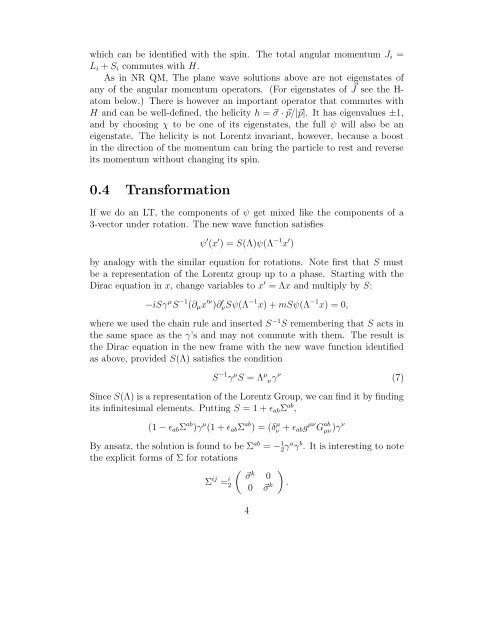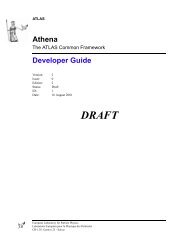0.1 Klein-Gordon Equation 0.2 Dirac Equation
0.1 Klein-Gordon Equation 0.2 Dirac Equation
0.1 Klein-Gordon Equation 0.2 Dirac Equation
You also want an ePaper? Increase the reach of your titles
YUMPU automatically turns print PDFs into web optimized ePapers that Google loves.
which can be identified with the spin. The total angular momentum J i =<br />
L i + S i commutes with H.<br />
As in NR QM, The plane wave solutions above are not eigenstates of<br />
any of the angular momentum operators. (For eigenstates of ⃗ J see the H-<br />
atom below.) There is however an important operator that commutes with<br />
H and can be well-defined, the helicity h = ⃗σ · ⃗p/|⃗p|. It has eigenvalues ±1,<br />
and by choosing χ to be one of its eigenstates, the full ψ will also be an<br />
eigenstate. The helicity is not Lorentz invariant, however, because a boost<br />
in the direction of the momentum can bring the particle to rest and reverse<br />
its momentum without changing its spin.<br />
0.4 Transformation<br />
If we do an LT, the components of ψ get mixed like the components of a<br />
3-vector under rotation. The new wave function satisfies<br />
ψ ′ (x ′ ) = S(Λ)ψ(Λ −1 x ′ )<br />
by analogy with the similar equation for rotations. Note first that S must<br />
be a representation of the Lorentz group up to a phase. Starting with the<br />
<strong>Dirac</strong> equation in x, change variables to x ′ = Λx and multiply by S:<br />
−iSγ µ S −1 (∂ µ x ′ν )∂ ′ νSψ(Λ −1 x) + mSψ(Λ −1 x) = 0,<br />
where we used the chain rule and inserted S −1 S remembering that S acts in<br />
the same space as the γ’s and may not commute with them. The result is<br />
the <strong>Dirac</strong> equation in the new frame with the new wave function identified<br />
as above, provided S(Λ) satisfies the condition<br />
S −1 γ µ S = Λ µ ν γν (7)<br />
Since S(Λ) is a representation of the Lorentz Group, we can find it by finding<br />
its infinitesimal elements. Putting S = 1 + ɛ ab Σ ab ,<br />
(1 − ɛ ab Σ ab )γ µ (1 + ɛ ab Σ ab ) = (δ µ ν + ɛ abg µν G ab<br />
µν )γν<br />
By ansatz, the solution is found to be Σ ab = − 1 2γ a γ b . It is interesting to note<br />
the explicit forms of Σ for rotations<br />
( ) ⃗σ<br />
Σ ij = i k<br />
0<br />
2<br />
0 ⃗σ k .<br />
4
















